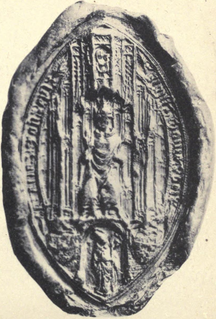Related Research Articles
Finan of Lindisfarne, also known as Saint Finan, was an Irish monk, trained at Iona Abbey in Scotland, who became the second Bishop of Lindisfarne from 651 until 661.
Tuda of Lindisfarne, also known as Saint Tuda, was appointed to succeed Colman as Bishop of Lindisfarne. He served for less than a year. Although raised in Ireland, he was a staunch supporter of Roman practices, being tonsured in the Roman manner and celebrating Easter according to the Roman Computus. However, he was consecrated as bishop in Ireland.

Eata, also known as Eata of Lindisfarne, was Bishop of Hexham from 678 until 681, and of then Bishop of Lindisfarne from before 681 until 685. He then was translated back to Hexham where he served until his death in 685 or 686. He was the first native of Northumbria to occupy the bishopric of Lindisfarne.
Eadberht of Lindisfarne, also known as Saint Eadberht, was Bishop of Lindisfarne, England, from 688 until his death on 6 May 698. He is notable as having founded the holy shrine to his predecessor Saint Cuthbert on the island of Lindisfarne, a place that was to become a centre of great pilgrimage in later years.

Eadfrith of Lindisfarne, also known as Saint Eadfrith, was Bishop of Lindisfarne, probably from 698 onwards. By the twelfth century it was believed that Eadfrith succeeded Eadberht and nothing in the surviving records contradicts this belief. Lindisfarne was among the main religious sites of the kingdom of Northumbria in the early eighth century, the resting place of Saints Aidan and Cuthbert. He is venerated as a Saint in the Roman Catholic Church, and in the Eastern Orthodox Church, as also in the Anglican Communion.
Æthelwold of Lindisfarne was Bishop of Lindisfarne from 721 until 740.
Cynewulf of Lindisfarne was appointed as Bishop of Lindisfarne in either 737 or 740. He resigned the see in 779 or 780 and died in 782 or 783.
Aldhun of Durham, also known as Ealdhun, was the last Bishop of Lindisfarne and the first Bishop of Durham. He was of "noble descent".
Egbert of Lindisfarne was Bishop of Lindisfarne from his consecration on 11 June 803 until his death in 821. He is often confused with Saint Egbert who served as a monk at Lindisfarne, though the latter never became a bishop there.

Thomas de Brantingham was an English clergyman who served as Lord Treasurer to Edward III and on two occasions to Richard II, and as bishop of Exeter from 1370 until his death. De Brantingham was a member of the Brantingham family of North East England.

The Bishop of Hexham was an episcopal title which took its name after the market town of Hexham in Northumberland, England. The title was first used by the Anglo-Saxons in the 7th and 9th centuries, and then by the Roman Catholic Church since the 19th century.
Ecgred of Lindisfarne was Bishop of Lindisfarne from 830 until his death in 845.
Eanbert of Lindisfarne was Bishop of Lindisfarne from 845 until 854. He was the penultimate bishop to reside at Lindisfarne, which by this time was regularly being invaded by Vikings.
Eardulf of Lindisfarne was Bishop of Lindisfarne for 46 years between 854, following the death of his predecessor, and his own death in 899. He was chiefly responsible for removing the remains of St Cuthbert from Lindisfarne to protect them from Viking invasions, eventually resettling them in Chester-le-Street and temporarily running the see from there.
Tilred of Lindisfarne was Bishop of Lindisfarne between around 915 and until his death around 925.
Uchtred of Lindisfarne was appointed as Bishop of Lindisfarne perhaps around 942. His death date is unknown.

The Bishop of Durham is the Anglican bishop responsible for the Diocese of Durham in the Province of York. The diocese is one of the oldest in England and its bishop is a member of the House of Lords. Paul Butler has been the Bishop of Durham since his election was confirmed at York Minster on 20 January 2014. The previous bishop was Justin Welby, now Archbishop of Canterbury. The bishop is one of two who escort the sovereign at the coronation.
Æthelric was Bishop of Durham from 1041 to 1056 when he resigned.
Robert of Holy Island was a medieval Bishop of Durham.
Heathwred of Lindisfarne was Bishop of Lindisfarne from 821 until his death in 830.
References
- Fryde, E. B.; Greenway, D. E.; Porter, S.; Roy, I. (1996). Handbook of British Chronology (Third revised ed.). Cambridge, UK: Cambridge University Press. ISBN 0-521-56350-X.